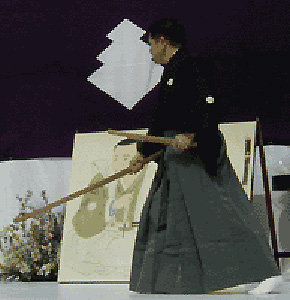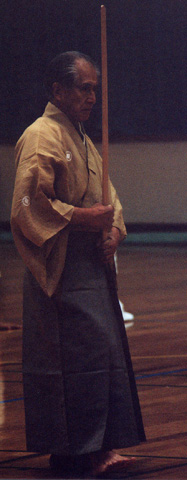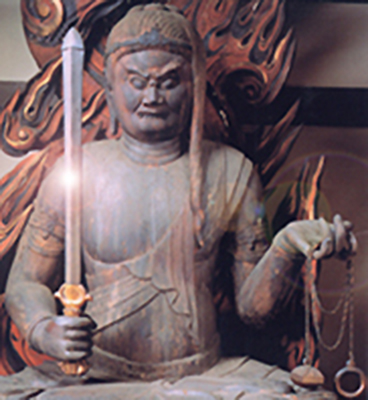 |
On Gorin no Sho: Miyamoto Musashi wrote the Hyoho Sanjugo Kajo (35 articles on Strategy), Gorin no Sho, and Dokkodo ( The way of Self Reliance). Gorin No Sho is the most famous of these writings and has been translated into many languages. Looking down from Reigando where Musashi lived and wrote Gorin no Sho |
 |
I have heard that a translation of this book has become a best seller in the United States, France and Germany. Many people may interpret this book differently depending on their divergent backgrounds and experiences. Readers may regard this book simply as a sword tactics manual of one of the Ryu, as a parallel of the Buddhist Sutras, a book explaining spiritual awakening or as a reference book for business. Notwithstanding if one does not study the Buddhist Sutras, one will never understand, however hard one reads.
|
|
On opening the book one will find a Prologue. Niten Ichiryu believes that this prologue is a very important teaching, because it explains the process of how the book was written. It consists of two parts: Hokki Jo (Initiation Prologue) and Kikei Jo (Prologue of total self devotion to Buddhist Law) In Hokki Jo, Miyamoto explains why he wrote the book. The Kie in Kikei Jo means to believe in, worship and respect (the Buddhist Law or a Buddhist saint). It means something spiritual that one embraces and respects and depends on. It means attitude (form) as when one bows ones head with ones hands clasped in prayer showing respect to a spiritual being. Miyamoto regarded himself as being in spiritual dependency with Tendo (the natural law) and Kanzeon (the Merciful Goddess) as his mirrors. As he began to write the book he devoted himself to them with hands clasped in prayer. The Prologue: It presents Miyamoto as a person who depended upon Kie, realising Hyoho (the path to enlightenment) as a means, he stood up in the absolute world and succeeded in developing himself . Although the Prologue states, The way to heaven and the Merciful Goddess as a mirror: The meaning of this phrase refers to not understanding as, Certain as the mind by reflecting on it. Also by uniting with the merciful goddess through everyday life and believing in heaven and the Merciful Goddess. The mirror means teaching. When we are given the teaching. It is like a mirror, and we recognise ourselves for the first time. The next statement that we must not miss in the Prologue is, I came to the realisation that I had won, not because I had attained the full secrets of swordsmanship. Miyamoto had aspired to Hyoho since his youth, overcome various difficulties, won almost sixty fights at the risk of his life, relentlessly trained himself by risking death. He won the fight against Koijiro Sasaki on Ganryu when he was twenty nine years old. However Miyamoto asked himself, What does winning mean? He realised that he had won up to that point by chance. There was no absolute promise of winning whenever, wherever or however he fought. As long as he lived he would grow older ill and die. If a swordsman became ill or injured at some time or hurt himself, some one was aware of swordsmanship could easily strike him down. As he became old even a woman or a child would be able to beat him. In other words, one can only win in times of good health. In this case no matter how hard one practices and studies Kenjutsu and raises oneself to an masterful standard it will all be a waste of time if one is ill. What a hopeless situation. All the effort will be in vain.
He came to the conclusion, The previous victories were not due to me having mastered strategy. My Hyoho was merely the result of earthly desires. It was coarse of me.. In this process of thinking he abruptly reached spiritual enlightenment. |
Senki -Fighting Spirit: Written by Miyamoto Musashi
 |
AWAKENING: This awakening is a great revolution in the philosophy of Buddhism. To turn ones thoughts towards Buddhist ends means, To establish oneself in the world of self realisation. This changing mind Spiritual awakening means that human beings fail when they rely on intellect. Stating further, this awakening means to take one step forward from the Hyakushaku Kanto (the top of the one hundred foot pole) to reach the eternal world. Understand the prologues point, The previous victories were not due to having mastered strategy and you will understand Gorin no Sho thoroughly. Tatsu means to awaken oneself, to free oneself and find the true spirit. Enlightenment came to Miyamoto after having a number of confrontations with swordsmen at the risk of his life between the ages of thirteen and twenty nine and he experienced the failure of human intellect. He could not find the utmost world in the hardest training or fights. When Miyamoto solved problems, he had always depended too much on his common sense. Therefore his master strategy was useless for attaining self realisation. For the first time he awoke and found a way he could trust himself. To feed himself through Hyoho. This is the tatsu which he meant, the utmost state, the rebirth of Miyamoto. |
|

